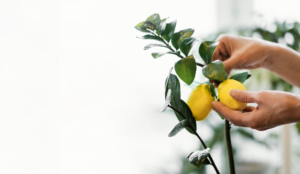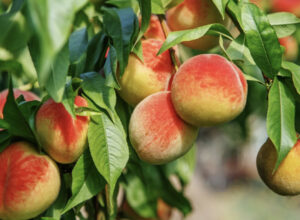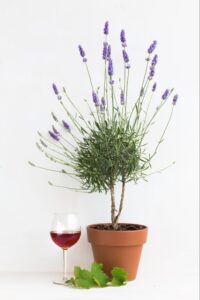Mastering Lavender Tree Care: A Comprehensive Guide

The enchantment of a lavender tree lies not just in its visual appeal but also in the aromatic ambiance it introduces to any space. These gems are known for their delicate blossoms and soothing fragrance, enhancing the aesthetics of homes and gardens alike.
In this article, we dive deep into actionable strategies to cultivate a healthy lavender tree, elaborating on their types, the nuanced care they require, and solutions to common challenges faced in their upkeep.
Understanding the Lavender Tree
A lavender tree is more than a source of aromatic pleasure; it’s a visual delight that can transform any space with its lush green foliage and soft purple blooms. It can be a striking addition to both indoor and outdoor environments. This aromatic woody plant originates from the Mediterranean but has found its place in gardens worldwide due to its adaptability and resilience.
Known for their calming and elegant aroma, the grey-green leaves and delicate purple flowers of the lavender tree are not just aesthetically pleasing but are also embedded with therapeutic properties. Lavender is celebrated in the wellness community for its calming effects, often featured in an array of wellness and beauty products.
Types of Lavender Trees
The world of lavender is diverse, with various species each boasting distinct characteristics. Notable types include the English Lavender (Lavandula angustifolia), renowned for its cold hardiness and rich fragrance; Spanish Lavender (Lavandula stoechas), identifiable by its prominent, pinecone-shaped blooms; and French Lavender (Lavandula dentata), adored for its prolonged blooming period.
Each type requires specific care techniques to thrive:
- English Lavender: Flourishes in well-drained soil and full sunlight.
- Spanish Lavender: Prefers warmer climates and is relatively drought tolerant.
- French Lavender: Needs a combination of sunlight and partial shade, ideal for indoor cultivation.
The Distinct Nature of Lavender Trees
While traditional lavender grows as a bushy herb, the lavender tree is distinct, showcasing a tree-like stature resulting from meticulous training and pruning. Its elegance lies in the tree form, a captivating sight that adds a touch of sophistication to its surroundings.
These trees are generally compact, reaching a height of 2-3 feet, making them suitable for indoor settings or as a refined addition to gardens. Their maintenance involves attentive pruning to preserve the tree-like appearance and ensure vibrant growth.
Caring for Lavender Trees
Cultivating a healthy lavender tree necessitates a comprehensive understanding of its needs. These include optimal sunlight exposure, proper watering regimen, and regular pruning.
- Sunlight: Lavender trees flourish under full sun, requiring at least six hours of direct sunlight daily.
- Water: They prefer well-drained soil, ensuring the roots are not waterlogged.
- Pruning: Regular trimming not only maintains its shape but also promotes dense foliage and vibrant blooms.
Winter Care Solutions
During colder months, safeguarding your lavender tree is paramount. Moving them indoors or ensuring they are insulated from frost ensures they continue to flourish. Employing protective covers or relocating them to a sheltered location can mitigate the adverse effects of harsh weather conditions.
A lavender tree stands as a testament to nature’s elegance, offering not just aesthetic pleasure but a sensory experience that transcends the visual. With informed care, these trees can become a long-lasting treasure, radiating their calming aroma and subtle beauty throughout your space. Equip yourself with the nuanced insights provided herein to nurture a thriving lavender tree that graces its surroundings with a blend of visual and aromatic splendor.
Winter can be a challenging season for lavender trees. Despite their inherent resilience, protective measures are integral to safeguard them from the harsh winter conditions. Mulching around the tree’s base serves to insulate the roots from the freezing temperatures. Further, wrapping them with frost cloths or burlap can shield them from chilly winds and frost, ensuring they survive the winter and bloom with renewed vigor in the spring.
Indoor Pot Cultivation of Lavender Trees
Lavender trees are not just an addition to your garden but can accentuate the indoor aesthetic of your home. These elegant woody herbs can be housed in decorative pots or baskets to match your interior décor. The pot, preferably not exceeding 2 inches wider than the tree’s root ball, should be accompanied by adequate drainage to prevent water retention and the subsequent risk of root decay. Implementing a layer of rocks at the pot’s base can facilitate excess water escape. To augment their growth, lavender trees should be placed in locations that receive abundant sunlight but are void of direct air drafts, cold or warm.
During the summer months, transitioning them outdoors can be beneficial for their growth, offering them natural sunlight and nutrients essential for their health and aroma. The soil hosting these trees should be rich and fertilized, with an addition of agricultural lime to enhance their growth, aroma, and flower bloom.
Growing Potted Lavender
Potted lavender trees have become popular for their convenience and mobility. The key to flourishing potted lavender lies in the soil’s drainage capacity. A specialized potting mix for lavender or a homemade mix incorporating soil, sand, and perlite can be ideal.
The pot should be placed in a location that receives abundant sunlight for the tree’s optimal growth. Watering should be moderate, with intervals allowing the soil to dry, preventing water stagnation which can lead to root rot. The potted tree’s aesthetics and health can be enhanced by regular pruning.
Outdoor Lavender Tree Cultivation
Outdoor environments are the natural habitats for lavender trees, where they can bask in ample sunlight, an essential component for their growth. When planting, a hole, double the size of the tree’s root ball, facilitates root expansion. The soil around the roots should be filled and firmly pressed to eliminate air pockets.
Proper hydration is critical but should be balanced to prevent waterlogging. The soil’s top layer should be allowed to dry before subsequent watering. The outdoor environment also promotes natural pollination, thanks to the bees attracted to lavender flowers.
Detailed Care Practices
When grown indoors, care should focus on light management, water regulation, and winter protection. A south-facing window can be an ideal location for these trees during winter to access sunlight. Regular rotation ensures even light distribution, promoting balanced growth. Watering should be meticulous to keep the soil moderately moist but not soggy. Utilizing a tray beneath the pot can catch excess water, preventing root saturation.
Outdoor lavender trees thrive with ample sunlight and well-drained soil. They can be planted in garden beds, ensuring they are not overshadowed by larger plants. The outdoor environment offers natural pest control, with predatory insects keeping potential pests at bay. Fertilizers, preferably organic, can be applied sparingly to avoid over-fertilization, which can inhibit blooming.
Advanced Care Techniques
For enthusiastic gardeners seeking to elevate their lavender tree care, advanced techniques can be adopted. Soil testing can be done periodically to ascertain the nutrient and pH levels, informing the need for fertilization or soil amendment. Implementing a pruning schedule during spring can enhance aeration and light penetration, fostering robust growth. Additionally, companion planting with plants like roses can not only enhance garden aesthetics but also offer mutual pest protection.
In conclusion, whether indoor or outdoor, potted or in garden beds, lavender trees are a delightful addition to any space. With appropriate care centered on light management, proper watering, winter protection, and occasional pruning, these aromatic trees will not only thrive but also infuse your space with an alluring aroma and visual appeal. Adopting the outlined care practices will transform your lavender tree growing into a rewarding gardening experience.
Cultivating and Harvesting Lavender Trees
One of the most gratifying horticultural activities involves the nurturing and harvesting of lavender trees. Originating from seeds, cuttings, or young saplings acquired from nurseries, these aromatic wonders are a testament to the symbiotic relationship between human touch and natural growth. The initial steps involve identifying a location characterized by abundant sunlight and soil with excellent drainage properties. Soil pH, an often overlooked aspect, plays a pivotal role in the optimal growth of lavender. A neutral to slightly alkaline pH fosters the vibrancy and aromatic essence synonymous with these woody herbs.
- Spacing is an essential factor. The distance between individual trees should be adequate to facilitate air circulation, reducing the propensity for diseases and pests. A well-thought-out spacing strategy ensures each tree receives its fair share of nature’s benevolence, contributing to overall health and visual appeal.
- Trimming is a recurrent activity aimed at ridding the tree of faded blooms. This not only enhances the tree’s aesthetic appeal but also spurs the blossoming of new flowers, ensuring the lavender tree remains a continuous spectacle of beauty and aroma. The harvest period is characterized by an abundance of full blooms, a spectacle that is as visually gratifying as it is aromatically enriching.
Harvesting requires a meticulous approach. The flowers, ripe and rich in aroma, should be plucked before the onset of fading. This ensures that the harvested lavender retains its rich aroma and visual appeal. Drying the harvested flowers is an art in itself.
Hang them upside down in an area characterized by cool temperatures, absence of light, and excellent ventilation. This process ensures the preservation of the lavender’s aesthetic and aromatic qualities, making them a suitable addition to various household and culinary applications.
Conclusion
In wrapping up this comprehensive guide on lavender tree care, it’s evident that a meticulous and informed approach is fundamental in nurturing these aromatic plants to their full potential. Every aspect, from the choice of location, soil quality, and watering, to winter and indoor care, plays a pivotal role in determining the overall health, aesthetic, and aromatic appeal of the lavender tree.
Appropriate maintenance and a balanced integration of art and science guarantees that lavender trees serve not just as a visual delight but also as a reservoir of enchanting fragrances capable of revitalizing both interior and exterior environments. Whether positioned in containers to enhance indoor aesthetics or gracefully gracing outdoor gardens, fundamental care practices are rooted in ensuring adequate exposure to sunlight, consistent and suitable watering, and safeguarding against harsh climatic elements.
Moreover, the cultivation and harvesting process underscores the tree’s multifaceted appeal. As visual ornaments, they captivate with their blossoming beauty. As aromatic herbs, they enrich spaces with a distinct, calming scent. In harvesting, the drying process is crucial to preserve these attributes, making lavender a timeless addition to any environment.
Each variety of lavender, from the resilient English lavender to the exotic Spanish variant, brings a unique essence, character, and appeal. Nurturing them, therefore, isn’t just about following care protocols but also about understanding their unique needs and characteristics. The beauty of lavender tree care lies in the intricate dance between human intervention and natural growth processes. It’s a journey that, when executed with knowledge and precision, results in a thriving, blossoming, and aromatic lavender tree that stands as a testament to the harmonious coexistence of human touch and nature’s benevolence.
In this light, aspiring and seasoned horticulturists are encouraged to immerse themselves in the enriching journey of lavender tree care, where each step, from planting and nurturing to harvesting, is a gratifying experience. Each lavender tree, nurtured to its full potential, becomes not just a visual and aromatic spectacle but a symbol of the harmonious fusion of art, science, and nature. Every blossom, every whiff of its calming aroma, stands as a reminder of the beauty embedded in the meticulous, informed, and passionate care of lavender trees.




